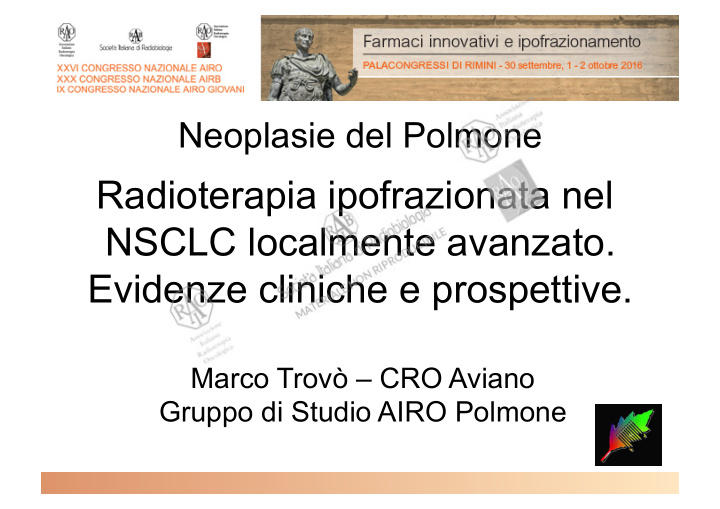



Neoplasie del Polmone Radioterapia ipofrazionata nel NSCLC localmente avanzato. Evidenze cliniche e prospettive. Marco Trovò – CRO Aviano Gruppo di Studio AIRO Polmone
DICHIARAZIONE Relatore: Marco Trovò Come da nuova regolamentazione della Commissione Nazionale per la Formazione Continua del Ministero della Salute, è richiesta la trasparenza delle fonti di finanziamento e dei rapporti con soggetti portatori di interessi commerciali in campo sanitario. • Posizione di dipendente in aziende con interessi commerciali in campo sanitario (NIENTE DA DICHIARARE) • Consulenza ad aziende con interessi commerciali in campo sanitario (NIENTE DA DICHIARARE) • Fondi per la ricerca da aziende con interessi commerciali in campo sanitario (NIENTE DA DICHIARARE) • Partecipazione ad Advisory Board (NIENTE DA DICHIARARE) • Titolarietà di brevetti in compartecipazione ad aziende con interessi commerciali in campo sanitario (NIENTE DA DICHIARARE) • Partecipazioni azionarie in aziende con interessi commerciali in campo sanitario (NIENTE DA DICHIARARE)
INTRODUCTION RTOG 0617 RTOG 0617
INTRODUCTION RTOG 0617
RTOG 0617 60 Gy vs.74 Gy IMRT Post 2D-RT 3D-CRT RTOG 0617 era ‘73-‘80 ’93-’00 ’03-’05 ’06-’11 doseline 60 74 60 83 Gy Gy Gy FDG-PET/CT Concomitant Chemotherapy
SBRT ? IMRT Post RTOG 0617 era Hypofractionation? 2D- 3D-CRT RT ‘80 ’93-’00 ’03-’0 ’06-’11 2013 5 60 83 74 60 Gy Gy Gy Gy
! Re-irradiazione: standard clinico o ricerca? Re-irradiazione neoplasie toraciche Marco Trovò Rimini, 9 Novembre 2015
Hypofractionation • Rationale • Clinical data • Points of discussion • Future directions
Hypofractionation • Rationale • Clinical data • Points of discussion • Future directions
Rationale for Hypofractionation 1. Radiation fraction size α / β is not favorable in lung cancer! Tumors might be heterogeneous, with clones which respond more like late- responding tissue.
Rationale for Hypofractionation 2. Repopulation It might be benefitial to employ shortened regimen
Rationale for Hypofractionation 3. Volume effect n: effect/volume parameter • n 0: serial organ (ex. cord): toxicity related to “dose effect” • n 1: parallel organ (ex. lung): toxicity related to “volume effect”
Tumori. 1992 Oct 31;78(5):305-10. Unfavorable experience with hypofractionated radiotherapy in unresectable lung cancer. Pirtoli L 1 , Bindi M, Bellezza A, Pepi F, Tucci E. The use of a reduced number of large-sized fractions in radiotherapy (hypofractionation) is usually associated with poor therapeutic results and severe adverse effects, in accord with radiobiologic concepts. However by some authors unresectable lung cancer patients have been treated with hypofractionated radiotherapy with the main aim of "convenience". Result and damage rates are reported to be comparable to those of conventional treatment. In our experience, based on palliative irradiation of 86 advanced-stage, nonmicrocytoma patients, objective remission rates, subjective and performance status improvement, and survival overall were as poor as could be expected in this kind of presentation, with no striking impact of this treatment modality. Severe adverse effects were shown by a large proportion of cases involving skin and soft tissues of the chest wall (40%) and lungs (55.5%). The incidence of severe damage was in agreement with BED (biologic effective dose) values, differently from other experiences of radiotherapeutic management of advanced lung cancer with large fractions.
Hypofractionation • Rationale • Clinical data • Points of discussion • Future directions
Kaster TS. Clin Lung Cancer 2015
Kaster TS. Clin Lung Cancer 2015
Main Limitations: • No robust and reliable toxicity data • Palliative treatments • ENI • No PET or IMRT • Retrospective studies • Prospective although observational studies
Radiotherapy Alone.
609 patients 55 Gy in 20 fr @2.75 Gy/fr OS: - median: 24 mo - 2-year: 50% Grade II pneumonitis: 20%
Considerations: - 200 patients were stage I - GTV-PTV margin: 15-20 mm - No PET - Toxicity recorded in 378 patients - No Grade ≥ 3 Toxicity
30 patients (stage III 77%; stage IV 23%) 60 Gy @3Gy/fr Induction chemo 80% Median PTV: 335 cc (range 73-682) LRR: 37% 2-Y OS: 38%.
Radiotherapy + Chemotherapy.
VNB+CDDPx4 55Gy/ 20 fr (2.75 Gy/fr) 130 Stage III R NSCLC pt. VNB+CDDP + 55Gy/20 fr
RT details: - Lung V20 < 35% - PET + disease (no ENI) - GTV PTV 1.5 cm - No IMRT
SOCCAR Concomitant Sequential Compliance to 95% 78% RT Grade 3-5 34% 41% toxicity Mortality 2.9% 1.7% Grade 3 3% 5% pneumonitis Median OS 24 mo 18 mo
66 Gy/24fr (2.75Gy/fr) + daily CDDP 102 Stage R II-III NSCLC 66 Gy/24fr + daily CDDP + Cetuximab
RT details: - MLD< 20 Gy - PET + disease (no ENI) - GTV PTV 1.2 cm - IMRT 75% - IGRT
Results: - Compliance to RT: 84%-88%. - Grade 3-5 tox: 45% - 65% - Grade 3 Pneumonitis: 0% - 6% - Median OS: 31 mo (no difference) - 2y OS = 60%; 5-y OS 37%
Hypofractionation • Rationale • Clinical data • Points of discussion • Future directions
Which fractionations to use with or without chemo? Any evidence of Dose Limiting Toxicity?
Which fractionations to use with or without chemo? A. No chemo. British Fractionation: 55 Gy in 20 fractions @ 2.75 Gy/fr. B. Concomitant chemo. - SOCCAR Trial: 55 Gy in 20 fr. + CDDP- VNBx2 - RADITUX Trial: 66 Gy in 24 fr + Daily CDDP
Any evidence of Dose Limiting Toxicity?
Isotoxic dose escaltion 63 Gy 73 Gy in 30 fr. Concurrent CDDP+VNB x 2
Esophageal MTD = 68 Gy in 30 fr. @ 2.26 Gy/fr - Grade 3 esophagitis < 6 %
Points of Discussion
Points of Discussion 57 Gy 85.5 Gy in 25 daily fractions 57Gy;63Gy;69Gy;75Gy;80Gy No concurrent chemo MTD: <20% risk of severe toxicity
Points of Discussion MTD = 63.25 Gy in 25 fractions ! = 70 Gy at 2Gy/fr Grade 4-5 toxicity: 1.8% vs. 31% p=0.0036
Points of Discussion Inserire appendice A
Points of Discussion
Hypofractionation • Rationale • Clinical data • Points of discussion • Future directions
Conclusions: • No randomized data on conventional vs. hypofractionated RT • Caution: DLTs exist! • Encouraging results are published • Future trials are justified
Thank you for your attention! marco.trovo@cro.it
Recommend
More recommend